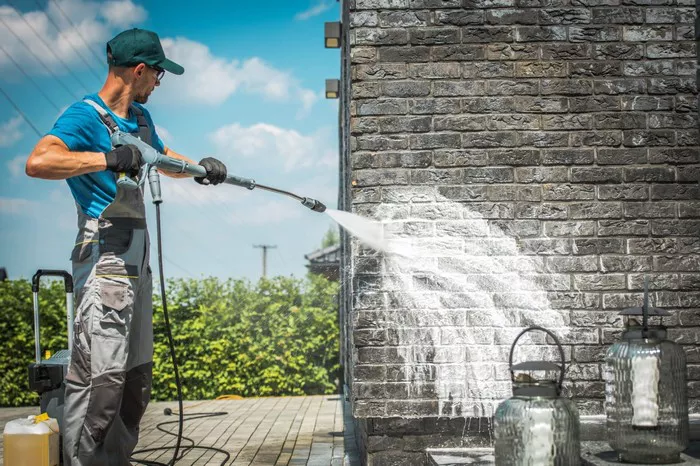Any building must have windows because they offer natural light, ventilation, and aesthetic appeal. But with time, they gather debris, filth, and other materials that can obstruct vision and lessen their appeal. Pressure washing, a widely used technique for cleaning a variety of surfaces, may appear like a practical way to clean windows as well. To prevent breaking windows, it’s crucial to know the possible dangers and the right methods for pressure cleaning them. We’ll discuss if pressure washing windows is a practical alternative, any potential advantages and disadvantages, and the safest methods for getting clean, shiny windows in this extensive guide.
Understanding Pressure Washing
Pressure washing is a very efficient technique to clean siding, decks, driveways, and sidewalks, among other exterior surfaces. It entails swiftly and effectively cleaning surfaces of filth, grime, mildew, and other debris with a high-pressure water stream. There are several varieties of pressure washers available, such as portable, gas-powered, and electric-powered machines, with differing pressure and functionality levels.
Can You Pressure Wash Windows?
Although pressure washing works wonders on a lot of outdoor surfaces, it should be used carefully on windows. Compared to many other surfaces, such concrete or brick, that are usually cleaned with a power washer, windows are more sensitive. If not handled properly, the high-pressure water stream has the potential to harm window glass, frames, seals, and caulking. Additionally, some stains or grime, including paint or hard water deposits, could not be successfully removed off windows by pressure washing.
Benefits of Pressure Washing Windows
Despite the risks involved, pressure washing windows can offer several benefits when done correctly:
1. Efficiency: Pressure washing can save time and effort compared to traditional methods of window cleaning, such as scrubbing with a sponge or using a squeegee.
2. Thorough Cleaning: A high-pressure water stream can reach areas that are difficult to access by hand, ensuring a more thorough cleaning of the window surface.
3. Eco-Friendly: Pressure washing typically requires less water and cleaning agents than traditional methods, making it a more environmentally friendly option.
4. Versatility: Pressure washers can be used for cleaning other outdoor surfaces, allowing for a comprehensive cleaning of the entire exterior of a building.
Drawbacks of Pressure Washing Windows
While pressure washing windows can be beneficial, it also comes with certain drawbacks and risks:
1. Potential Damage: The high-pressure water stream can damage window glass, frames, seals, and caulking if not used correctly, leading to costly repairs or replacements.
2. Safety Concerns: Using a pressure washer requires proper safety precautions, including wearing protective gear and ensuring a stable footing to avoid accidents or injuries.
3. Limited Effectiveness: Pressure washing may not effectively remove certain types of dirt or stains from windows, requiring additional cleaning methods or products.
4. Water Intrusion: Improper use of a pressure washer can force water into the building through gaps or cracks around windows, leading to water damage and mold growth indoors.
Best Practices for Pressure Washing Windows
If you decide to pressure wash your windows, follow these best practices to minimize the risks and achieve optimal results:
1. Choose the Right Equipment: Use a pressure washer with adjustable pressure settings and a nozzle specifically designed for gentle cleaning, such as a fan or wide-angle nozzle.
2. Use Low Pressure: Start with the lowest pressure setting and gradually increase as needed, being careful not to exceed the recommended pressure for window cleaning.
3. Maintain a Safe Distance: Keep the pressure washer nozzle at least 12 inches away from the window surface to prevent damage and ensure even cleaning.
4. Angle the Spray Properly: Hold the nozzle at a slight angle to the window surface rather than pointing it directly at the glass to reduce the risk of breakage or damage.
5. Pre-Wet the Surface: Spray the windows with water before applying detergent to loosen dirt and debris, making it easier to clean without relying solely on high pressure.
6. Use Mild Detergent: Choose a gentle detergent specifically formulated for use with pressure washers and suitable for cleaning windows to enhance cleaning effectiveness without causing damage.
7. Rinse Thoroughly: After applying detergent, thoroughly rinse the windows with clean water using the pressure washer to remove any remaining dirt, detergent, or debris.
8. Avoid Pressure Washing on Windy Days: Pressure washing windows on windy days can cause water and debris to scatter, increasing the risk of damage or injury.
9. Protect Surrounding Areas: Cover nearby plants, furniture, and other sensitive surfaces with plastic sheeting or tarps to prevent damage from overspray or runoff.
10. Inspect for Damage: After pressure washing, carefully inspect the windows for any signs of damage, such as cracks, chips, or water intrusion, and address any issues promptly.
Alternative Window Cleaning Methods
If pressure washing isn’t suitable for your windows or you prefer alternative methods, several options are available:
1. Traditional Hand Washing: Use a soft sponge or microfiber cloth along with a gentle cleaning solution to hand wash windows, followed by drying with a squeegee or lint-free cloth.
2. Window Cleaning Solutions: Commercial window cleaning solutions or homemade mixtures of water and vinegar or dish soap can effectively remove dirt and grime from windows without the need for a pressure washer.
3. Professional Window Cleaning Services: Hiring a professional window cleaning service ensures thorough and safe cleaning of windows using the appropriate equipment and techniques.
Conclusion
Although pressure washing windows may be a convenient and efficient cleaning solution, it is important to use caution when using this method to prevent damage and get the best results. You may keep clean, dazzling windows without sacrificing their integrity by being aware of the possible hazards, best practices, and alternate window cleaning techniques. The secret to keeping your windows functional and beautiful for many years to come is to prioritize safety and correct technique, whether you decide to pressure wash them or use another cleaning method.

